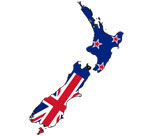 Total Area
Total Area
268,671 sq km
 CAPITAL
CAPITAL
Wellington
 Population
Population
4213418 (july2009)
 Climate
Climate
Both northern and southern islands enjoy moderate meritime climate ,weather and temperature
NewZealand Overview
 The Newzealand multicultural society of today is a result of migration from all parts of the worls beginning with maori from pacific and britishers in 18th century .The country is known for its sceinic beauty and exciting activities for thrill seekers and adventurers.
The Newzealand multicultural society of today is a result of migration from all parts of the worls beginning with maori from pacific and britishers in 18th century .The country is known for its sceinic beauty and exciting activities for thrill seekers and adventurers.
Newzealand is made of no of regions that offer unique features and landscapes.it is nestled in south pacific ocean 1600 km from australia.With its majestic mountain ranges ,sweeping plains ,imposing native forests,miles of golden sand beaches and numerous bays dotted around one of the largest coastlines of the world
Attractions
New Zealand is universally famous for its scenic beauty and exciting activities for thrill seekers and adventurers. People from all over the world visit New Zealand year-round. Tourism is a major industry for the country, which is great for students looking for recreation, opportunities to relax and experience new things.
Tours to nz brings back the zeal in life nature is yet to be domesticated in thi s small country where cattle outnumbers its population with each destination offering a different ecosystem and picturesque setting.geysers and glaciours coexist active volcanoes give way to gorgeous rivervalleys.the surrounding seas and oceans nestle harbours and exquisite marine life within its folds.
The national park are flourished with farmland beaches vineyards and luxurious resorts sweep you of your feet.it also houses 24 national parks.
History
Maoris were the first inhabitants of New Zealand, arriving on the islands in about 1000. Maori oral history maintains that the Maoris came to the island in seven canoes from other parts of Polynesia. In 1642, New Zealand was explored by Abel Tasman, a Dutch navigator. British captain James Cook made three voyages to the islands, beginning in 1769. Britain formally annexed the islands in 1840.
The Treaty of Waitangi (Feb. 6, 1840) between the British and several Maori tribes promised to protect Maori land if the Maoris recognized British rule. Encroachment on the land by British settlers was relentless, however, and skirmishes between the two groups intensified.
Geography
New Zealand, about 1,250 mi (2,012 km) southeast of Australia, consists of two main islands and a number of smaller outlying islands so scattered that they range from the tropical to the antarctic. The country is the size of Colorado. New Zealand's two main components are the North Island and the South Island, separated by Cook Strait. The North Island (44,281 sq mi; 115,777 sq km) is 515 mi (829 km) long and volcanic in its south-central part. This area contains many hot springs and beautiful geysers. South Island (58,093 sq mi; 151,215 sq km) has the Southern Alps along its west coast, with Mount Cook (12,316 ft; 3754 m) the highest point. Other inhabited islands include Stewart Island, the Chatham Islands, and Great Barrier Island. The largest of the uninhabited outlying islands are the Auckland Islands (234 sq mi; 606 sq km), Campbell Island (44 sq mi; 114 sq km), the Antipodes Islands (24 sq mi; 62 sq km), and the Kermadec Islands (13 sq mi; 34 sq km).
Culture
Twenty-first century New Zealand is a melting pot of cultures and lifestyles. For those keen to learn more about our Maori culture there are a range of experiences on offer. If 'culture' to you means art, food, wine and lifestyle, there is also plenty to indulge in, from world class wines and fine cuisine to luxury lodges and spas.



